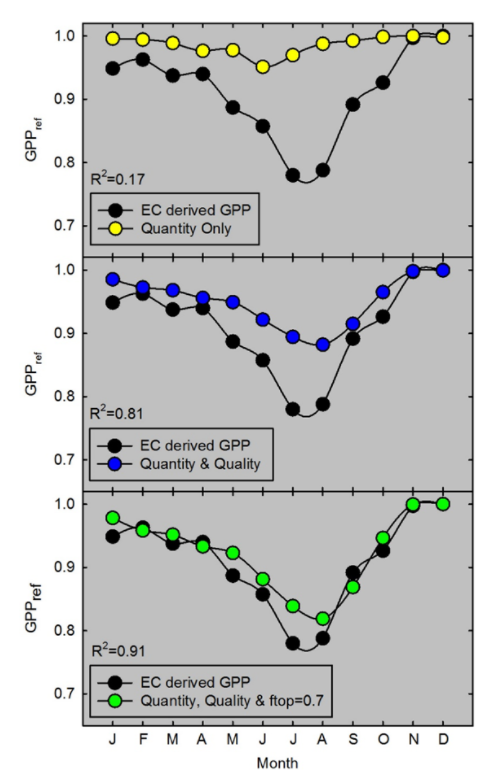The phenology of leaf quality and its within-canopy variation are essential for accurate photosynthesis modeling in tropical evergreen forests
The Science
The annual variation in tropical photosynthetic CO2 assimilation is about half the size of the terrestrial carbon sink and is therefore an important phenomenon to represent in terrestrial biosphere models (TBMs). Three components of leaf phenology (i.e. quantity, quality, and within-canopy variation) all regulate tropical forest photosynthesis, but are absent or poorly represented in most TBMs. Here, by we demonstrate how these three components can be integrated in a mechanistic representation of tropical evergreen forest photosynthetic seasonality. We show that the photosynthetic seasonality was not sensitive to leaf quantity, but was highly sensitive to leaf quality and its within-canopy variation, with markedly more sensitivity to upper canopy leaf quality. Our work thus highlights the importance of incorporating more realistic phenological mechanisms in TBMs that seek to improve the projection of future carbon dynamics in tropical evergreen forests.
The Impact
This study has three important implications for the broader ecology, plant physiology, and modeling communities. (1) Our work demonstrates that an improved and prognostic understanding and model representation of tropical leaf phenology will be a key component in new models that seek to improve projections of carbon dynamics and potential climate feedbacks in the tropics. (2) By isolating biological drivers of photosynthesis from weather, our work highlights the need to improve our understanding and model representation of the fundamental physiological response to environmental variability in the tropics. (3) Our work also highlights the data paucity in the tropics that currently limits our ability to test and evaluate the proposed model framework at broader scales.
Summary

The average annual cycle of canopy photosynthesis (i.e. Gross Primary Productivity, GPP) under a reference environment, GPPref (i.e. an indicator of canopy integrated photosynthetic capacity), of a central Amazonian evergreen forest in Brazil was derived from eddy covariance (EC) measurements (years 2002-2005 and 2009-2011; black lines). Here we used a two-fraction leaf (sun vs. shade), two-layer (upper vs. lower) canopy model to examine the effects of three phenological components (i.e. quantity, quality, and within-canopy variation) on modeled GPPref. The model incorporating only the effect of “leaf quantity” is shown in yellow line, which does not follow EC-derived GPPref seasonality. The model incorporating the joint effects of “leaf quantity and leaf quality” is displayed in the blue line, which tracks the pattern of EC-derived GPPref seasonality, but only captures ~1/2 of the relative annual change. The model incorporating the effects from all three phenological components (i.e. quantity, quality, and within-canopy variation, approximated by ftop) is shown in green line, and tracks EC-derived GPPref seasonality in both phase and the relative annual change. Our results thus suggest that the phenology of leaf quality and its within-canopy variation are essential for accurate photosynthetic modeling in tropical evergreen forests.
Contacts (BER PM): Daniel Stover, SC-23.1, Daniel.Stover@science.doe.gov (301-903-0289)
PI Contact
Lead author contact: Jin Wu, Brookhaven National Laboratory, jinwu@bnl.gov
Institutional contact: Alistair Rogers, Brookhaven National Laboratory, arogers@bnl.gov
Funding
Wu, SP Serbin, and A Rogers were supported by the Next-Generation Ecosystem Experiment (NGEE-Tropics) project. The NGEE-Tropics project is supported by the Office of Biological and Environmental Research in the Department of Energy, Office of Science.
Publications
Wu J, Serbin SP, Xu X, Albert LP, Chen M, Meng R, Saleska SR, Rogers A. The phenology of leaf quality and its within-canopy variation are essential for accurate modeling of photosynthesis in tropical evergreen forests. Global change biology, 2017, doi:10.1111/gcb.13725. http://onlinelibrary.wiley.com/doi/10.1111/gcb.13725/epdf